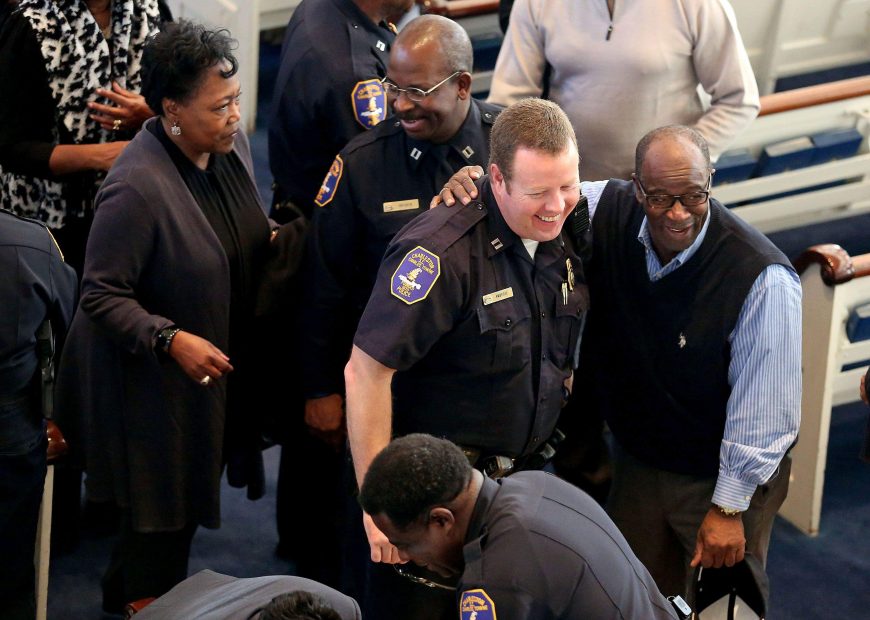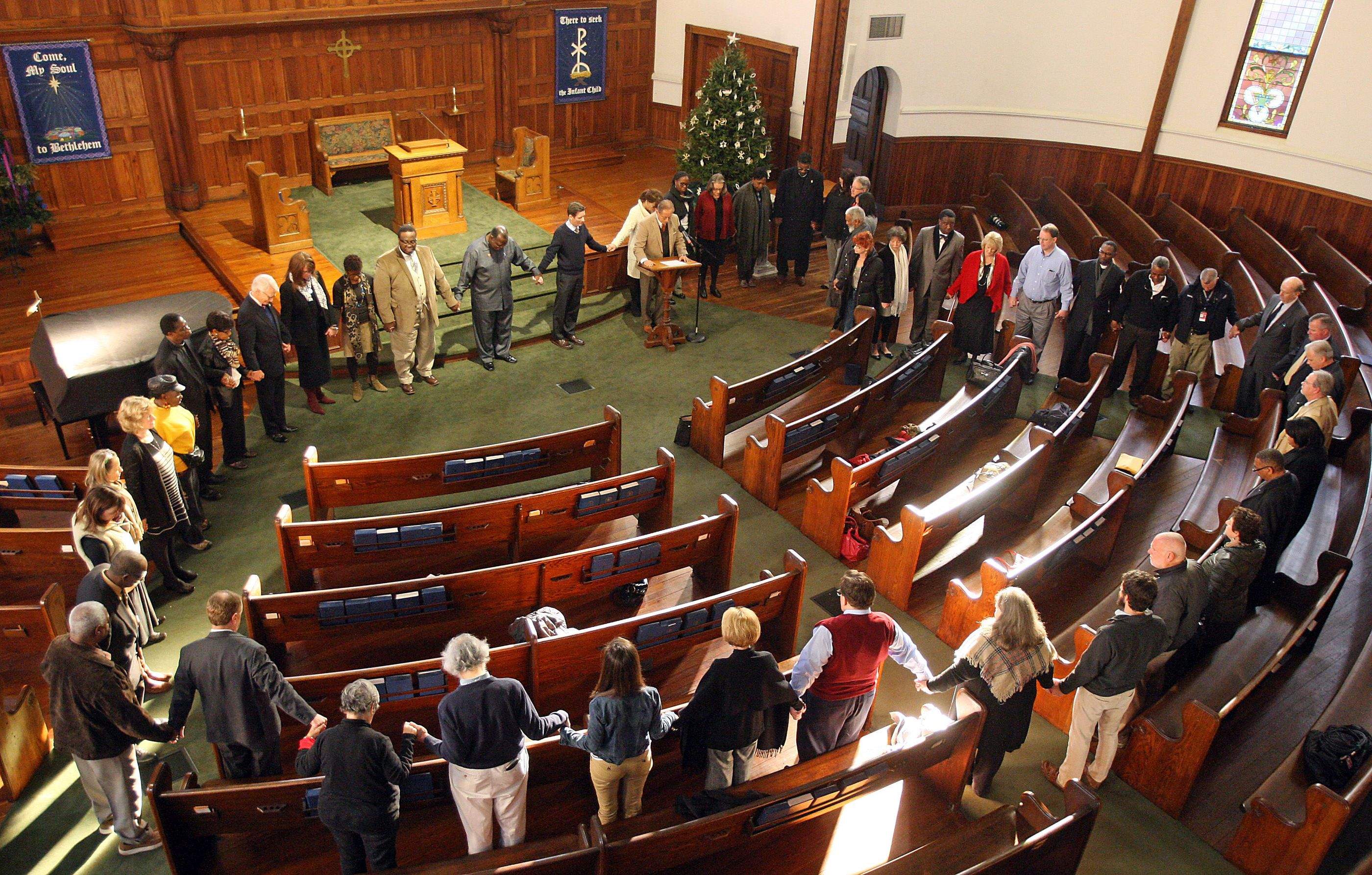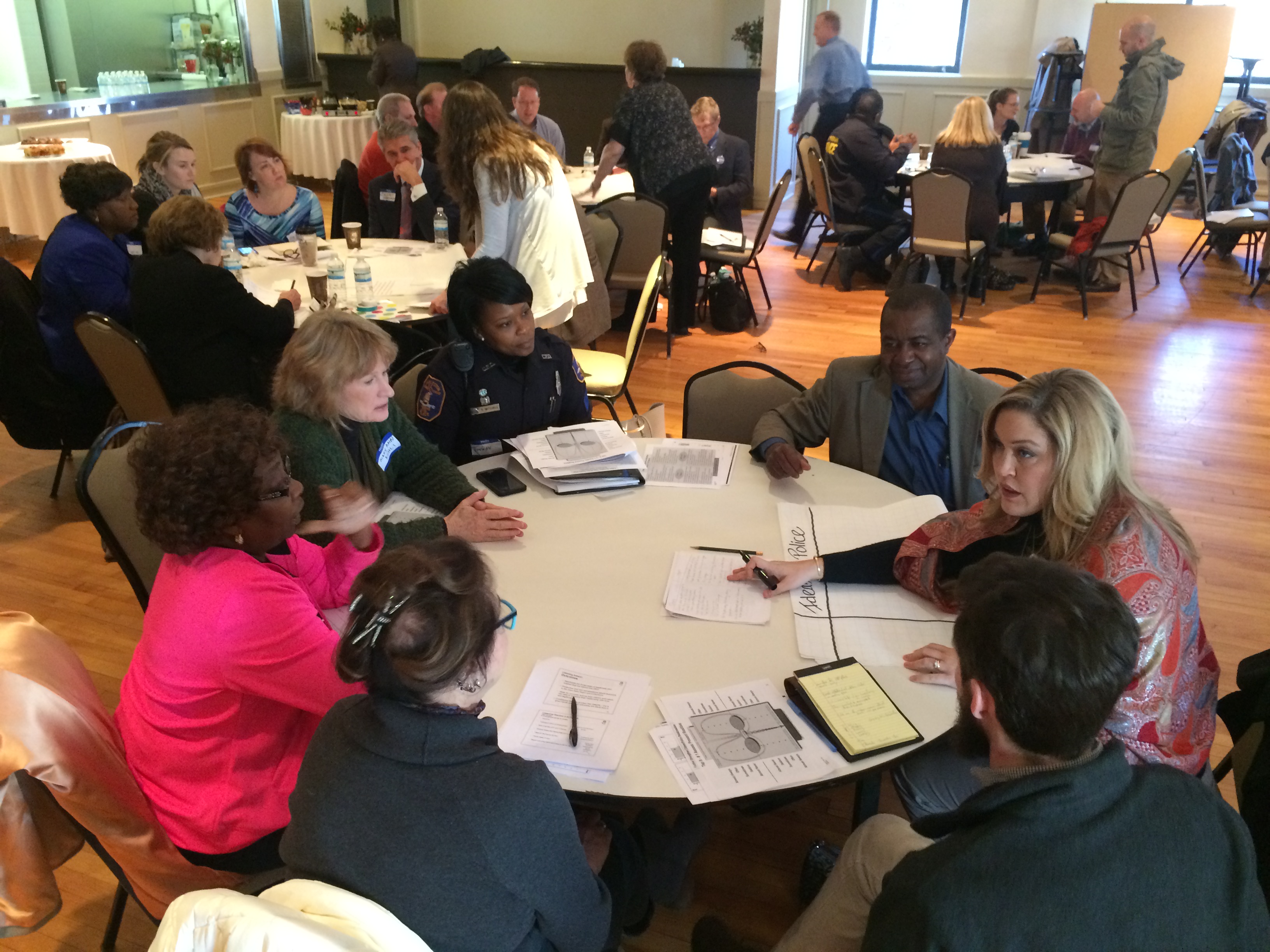Polarity Thinking*: The Approach Underlying All Illumination Project℠ Work
*Based on the work of Barry Johnson and Polarity Partnerships
Consider: Here’s a story of how Polarity Thinking helped the Charleston police department see a more holistic and balanced view of reality and in so doing provide effective policing services, a story of how Polarity Thinking’s unconventional approach adds value.
Looking through an “Either / Or” lens, people in the police department join one of two camps as the best path to Enhance Community Safety (one of CPD’s five-year goals). One group of officers believes it’s best to focus on enforcement. Do it well they argue and you can decrease crime, fulfill the department’s mission to enforce laws, improve citizens’ quality of life by reducing fear of crime, and take a proactive approach to problems. What are they worried about? A disregard for the law, the community dictating enforcement priorities, reduced quality of life due to fear of crime and a reactive approach to problem solving. These officers are clear, committed and their energy is focused on one thing: the community’s greater good. This group saw Community Support as something that could become too soft, frivolous, and something that would eventually get in the way of reducing crime.
But another group of officers sees things differently. They argue, “Developing community support is the way to go.” Follow this path they say and you share accountability for safety, citizens understand enforcement strategies, open communication leads to stronger relationships, and trust with citizens continues to be enhanced. What’s their worst-case scenario? Focus too much on enforcement and you’re stuck with a “Big Brother” relationship with the community, citizen’s feeling a loss of liberty from the lack of understanding enforcement strategies, fear of police and an “Us” vs. “Them” mentality. They believe that too much focus on Enforcement would be experienced by the community as overly harsh, punitive, and shutting down communication and trust between police and the citizens they serve. This group cares as much as the first about the community’s greater good
In this scenario people who need to collaborate end up in conflict. Each holds a common – though flawed – assumption of the other: “If I’m right, then you must be wrong.” The stronger the case one group makes, the deeper the other digs in its heels.
Two groups. One goal of Enhancing Community Safety. Two solutions. Which one is right? They both are. The fallacy is that each of them is only half-right. Enforcement and Developing Community Support is not a problem that can be solved from an “Either / Or” mindset. It’s what we call a polarity that needs to be leveraged from a “Both / And” point of view because the two views are interdependent.
The “Both / And” Lens: Seeing the Whole Picture
Let’s tell the same story, this time through a “Both / And” lens. You decide to increase enforcement to decrease crime. Crime figures go down, performance improves and morale improves so you increase your focus on enforcement even more. Everything appears to be on track…until you realize it isn’t.
The enforcement focus that helped reduce crime has undermined trust and community relationships, leading to a weaker partnership between police and the people they serve What had been celebrated as a proactive approach is now perceived as creating an “Us” vs. “Them” mindset. (A). What can help put the department back on track? Share accountability for safety with citizens and help citizens understand enforcement strategies. (B). This response is strategic, yet it isn’t the only strategic thing to do.
Paradoxically, focusing on enforcement is not sustainable without also paying attention to developing strong community support. Enforcement without enough focus at the same time on community support and you’ll find yourself in the downside of Enforcement alone (C) – “Big Brother,” Loss of liberty from the lack of understanding enforcement strategies, fear of the police and an “Us” vs. “Them” mentality. Now you have created another set of problems that need to be solved. The solution to these problems is to once again develop stronger community support to enhance community support D).
And so it goes…today’s solution becoming tomorrow’s problem. The harder you try to fix each of these problems, the bigger they get. The more each group is committed to the department’s success, the more energy ends up working against you in your organization.
See Polarities and Get The Energy in Your Organization Working For You
How do you break this vicious cycle of energy working against you? Stop treating this challenge as a problem to solve and start to leverage it as a polarity. Polarities are interdependent pairs that can support one another in pursuit of a common purpose. They can also undermine each other if seen as an either/or problem to solve. Like enforcement and community support, both are needed for sustained organizational success.
The answer to “Should we be focusing on enforcement or community support?” “Yes.” Find ways to get people’s energy for each pole, or point of view, working together and you create a virtuous cycle of energy working for you in your department.
Once you do, you can design an organization that leverages the benefits of Enforcement (B) AND Community Support (D) and minimizes the costs of over-focusing on either (C and A). Neither Enforcement nor Community Support is sustainable without the other over time. Intentionally pay attention to both and you increase performance that Enhance Community Safety much more than any department that sees one pole or the other as a solution to a problem.
If determining how to get the best of Enforcement AND Community Support isn’t your organization’s issue, pick another one. Do you struggle with the challenges of delivering daily operations and developing your people at the same time? How do you make big changes and provide the continuity people need to implement them? How do we get the new resources we need while taking good care of those we already have?
Over-focus on any one of these choices to the relative exclusion of the other too long and you’ll undermine what’s been working for you and fall short of what you’re trying to achieve.
When you’re taking advantage of polarity energy, as the Charleston Police Department did by identifying a key polarity for each strategic direction, the game changes. Your biggest troublemakers become critical resources. Think of it this way: they’re paying attention to something you’re not — something you need to pay attention to if you want to succeed. Majorities don’t rule when it comes to polarities. The fewer the people holding a pole, the more you need to listen to what they have to say.
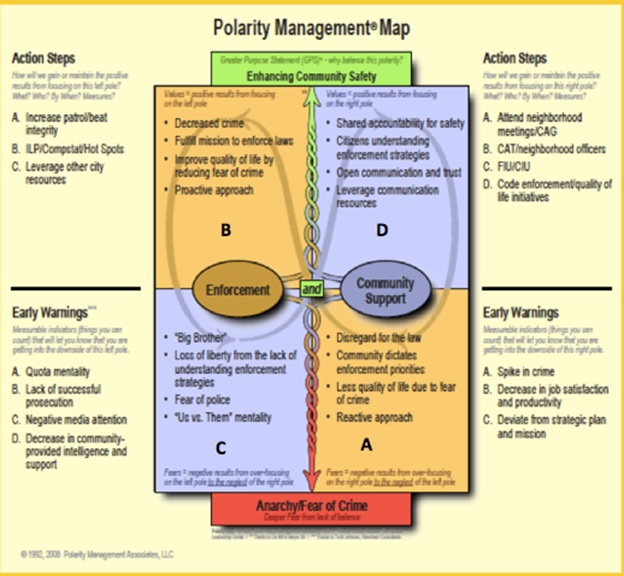
Real Time Strategic Change: Creating Your Preferred Future Faster and More Sustainably
Real Time Strategic Change (RTSC) is a principle-based approach to achieving fast and lasting results. It is based on and supportive of Polarity Thinking. It was borne out of the pioneering work Robert “Jake” Jacobs did in the area of Large Group Interventions. With roots working in large groups, RTSC is a valuable addition to the community-wide efforts.
The Six Real Time Strategic Change Principles
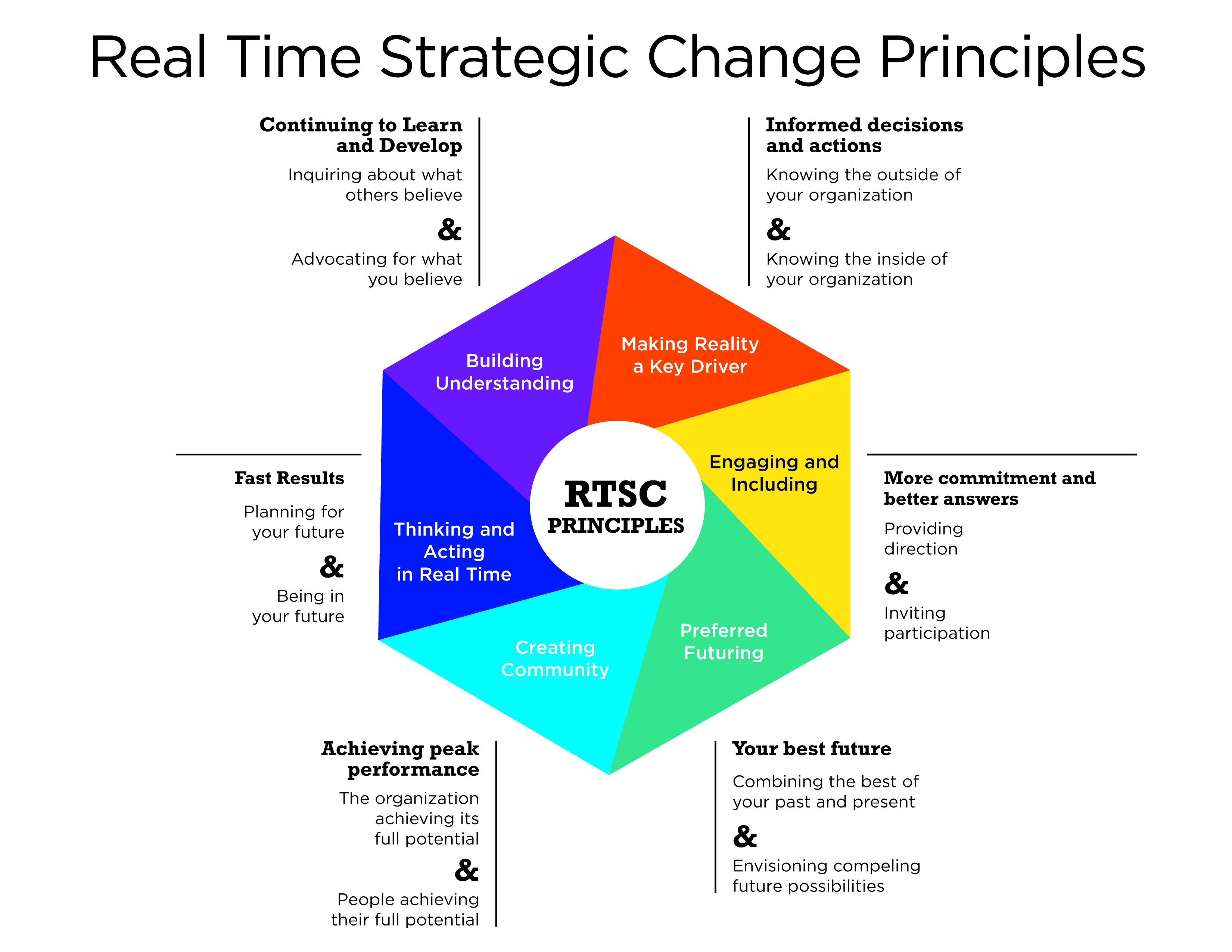
Making Reality A Key Driver
Know the inside of your organization and also know the outside too. Put together what you learn and you’ll make informed decisions and take strategic actions.
For example, with Real Time Strategic Change your Illumination Project includes information from both within your community via the Listening Sessions, leadership group meetings and research. It also includes looking out at other cities and national studies to supplement these internal views.
Engaging and Including
Provide clear direction and invite participation. Lead in both ways and you’ll make smarter choices and create the commitment needed for fast and lasting change.
For example, sometimes the most engaging and inclusive thing leaders can do is to create “bright lines” about boundaries and requirements for their people to follow. The Listening Sessions were very tightly designed and facilitated. Paradoxically this structure created the needed freedom for people to feel safe to voice their true concerns.
Preferred Futuring
Combine the whole of your past and present and compelling visions for your future. Build this picture and you’ll create your best future.
For example, the Listening Sessions all begin with a question that takes people back to what they love about living in their community. A common question to create common ground. There is also an honest “look back” at the current state of police/citizen relationships across the country. To create tension that can be leveraged with these difficulties there are questions later in the Session about people’s hopes and fears for the future.
Creating Community
Ensure you focus on both the community as a whole achieving its full potential while at the same time finding ways for each part of the community and people in it to achieve their full potential. Do this and people achieve peak performance by becoming part of something larger than themselves that they have created and believe in.
For example, people throughout your community care deeply about its future. And they also care about their “part” of the community — be it geographical, faith-based, sexual orientation, gender, socio-economic class and many others. In creating communities everyone wins…or no one does.
Thinking and Acting in Real Time
Be in your future and plan for it at the same time. Learn to do them equally well and your desired future will happen faster.
For example, if you were living in your community in the ways you want to in the future right now, how would you be behaving and engaging with your police and fellow citizens? Who would be involved in making decisions regarding certain issues? Building the Strategic Plan is a major effort in an Illumination Project and yet, any good idea gets implemented as soon as possible. Live your future while you plan for it at the same time
Building Understanding
Stand up for what you believe in and be curious about what others think. Support both interests and you will continue to learn and develop – individually, in your teams and as an entire organization.
For example, the entire premise of The Illumination Project is built upon the tension of inquiry and advocacy. The fascinating aspect you see unfold is that the more vigorously people explore another’s point of view, the more space they have to share their own.
Solid RTSC work leads to fast and lasting results. The more you live these Principles as an individual leader, team or community you’ll accelerate realizing your preferred future and sustain it longer over time.
